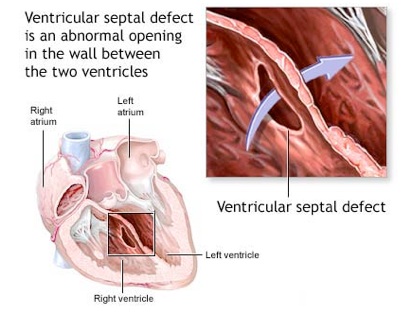resources


resources


Saturday, February 21, 2009
Ventricular septal defect describes one or more holes in the wall that separates the right and left ventricles of the heart. Ventricular septal defect is one of the most common congenital (present from birth) heart defects. It may occur by itself or with other congenital diseases.
Causes
Before a baby is born, the right and left ventricles of its heart are not separate. As the fetus grows, a wall forms to separate these two ventricles. If the wall does not completely form, a hole remains. This hole is known as a ventricular septal defect, or a VSD.
Ventricular septal defect is the most common congenital heart defect. The baby may have no symptoms, and the hole can eventually close as the wall continues to grow after birth.
If the hole is large, too much blood will be pumped to the lungs, leading to heart failure. These babies often have symptoms related to heart failure and may need medicine to control the symptoms and surgery to close the hole. The hole can also be closed without surgery, through cardiac catheterization.
The cause of VSD is not yet known. This defect often occurs along with other congenital heart defects.
In adults, ventricular septal defects are a rare but serious complication of heart attacks. These holes are related to heart attacks and do not result from a birth defect.
Symptoms
Patients with ventricular septal defects may not have symptoms.
The most common symptoms, however, include:
•Shortness of breath
•Fast breathing
•Hard breathing
•Paleness
•Failure to gain weight
•Fast heart rate
•Pounding heart
•Sweating while feeding
•Frequent respiratory infections
Exams and Tests
Listening with a stethoscope usually reveals a heart murmur (the sound of the blood crossing the hole). The loudness of the murmur is related to the size of the defect and amount of blood crossing the defect.
Tests may include:
•Chest x-ray may show a large heart with fluid in the lungs
•ECG shows signs of an enlarged left ventricle
•Echocardiogram
•Cardiac catheterization (rarely needed, unless there are concerns of high blood pressure in the lungs, in which case surgery to close the defect is generally not recommended)
•MRI of the heart -- used to find out how much blood is getting to the lungs
Treatment
If the defect is small, no treatment is usually needed. However, the baby should be closely monitored by a health care provider to make sure that the hole eventually closes properly and signs of heart failure do not occur.
A doctor may prescribe medications, such as digitalis (digoxin) and diuretics, for heart failure.
Regardless of the size of the defect, all children with ventricular septal defect need to take antibiotics before undergoing dental work and certain other invasive procedures.
If symptoms continue despite medication or the VSD leads to a heart infection, surgery to close the defect with a Gore-tex patch is needed. Some VSDs can be closed with a special device during a catheterization.
Surgery for a VSD with no symptoms is controversial. This should be carefully discussed with your health care provider.
Outlook (Prognosis)
Many small defects will close on their own. For those defects that do not spontaneously close, the outcome is good with surgical repair. Complications may result if a large defect is not treated.
Possible Complications
•Heart failure
•Infective endocarditis (bacterial infection of the heart)
•Aortic insufficiency (leaking of the valve that separates the left ventricle from the aorta)
•Damage to the electrical conduction system of the heart during surgery (causing arrhythmias)
•Delayed growth and development (failure to thrive in infancy)
•Pulmonary hypertension (high blood pressure in the lungs) leading to failure of the right side of the heart
When to Contact a Medical Professional
Most often, this condition is diagnosed during routine examination of an infant. Call your infant's health care provider if the baby seems to be having difficulty breathing, or if the baby seems to have an unusual number of respiratory infections.
Prevention
Except for the case of heart attack associated VSD, this condition is always present at birth.
Drinking alcohol and using the antiseizure medicines depakote and dilantin during pregnancy have been associated with increased incidence of VSDs. Other than avoiding these two things during pregnancy, there is no known way to prevent a VSD.
Alternative Names
VSD; Interventricular septal defect
References
Zipes DP, Libby P, Bonow RO, Braunwald E, eds. Braunwald's Heart Disease: A Textbook of Cardiovascular Medicine, 8th ed. St. Louis, Mo; WB Saunders; 2007.


Ventricular Septal Defect (VSD)